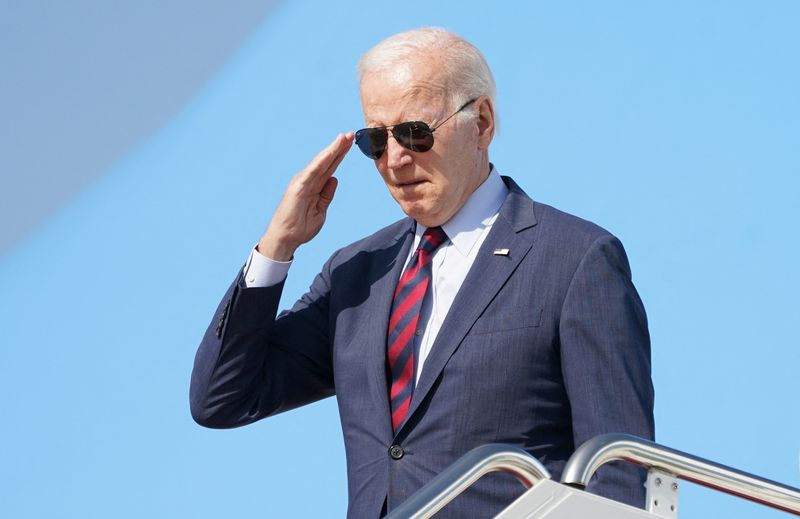
© Reuters. FILE PHOTO: U.S. President Joe Biden salutes as he boards Air Force One to depart from Joint Base Andrews in Maryland, U.S., May 31, 2023. REUTERS/Kevin Lamarque
By Andy Sullivan
WASHINGTON (Reuters) – The bipartisan debt-ceiling deal that could clear Congress as soon as Thursday would stave off an imminent U.S. default, but might deliver less budget savings than Republicans have hoped for, according to nonpartisan budget analysts.
The agreement ensures that President Joe Biden will not have to grapple with another debt-ceiling showdown until after the November 2024 election.
Top congressional Republican Kevin McCarthy, for his part, secured $1.3 trillion in spending cuts as part of his party’s effort to scale back government and rein in the growth of U.S. debt.
That is less than the $4.8 trillion Republicans had initially sought, but still the largest deficit-reduction package since a 2011 deal that emerged from a similar debt-ceiling showdown.
But many of the savings from this week’s agreement could be illusory.
Congress would be free to abandon its proposed spending caps after two years, as it did following the 2011 agreement. That would put more $1 trillion of the deal’s anticipated savings at risk, according to the Penn Wharton Budget Model, a research group.
The deal also includes exemptions that could allow lawmakers to sidestep the short-term spending limits as well.
Still, supporters say it is a good first step on the road to fiscal stability, reflecting the realities of divided government in Washington.
“The goal is to get as much savings as is gettable, and I have a strong sense that this is where they landed,” said Maya MacGuineas, head of the Committee for a Responsible Fiscal Budget, a nonpartisan advocacy group.
Biden secured numerous exemptions that could allow his administration to tap other pots of money, such as unspent COVID-19 aid, to fill spending gaps.
The White House estimates that spending on domestic discretionary programs like housing and education would be flat next year, rather than the 8% cut specified in the legislation.
“There’s a lot of caveats to these caps that could render all of this relatively meaningless,” said Veronique de Rugy, a libertarian economist at George Mason University’s Mercatus Center.
And the law leaves Biden’s signature green-energy tax breaks intact, which Penn Wharton estimates could cost the government up to $1 trillion, more than three times the original estimate.
Republicans, for their part, allowed other priorities to blunt their effort to reduce budget deficits.
The deal increases spending on defense and veterans’ care, even as it aims to clamp down on other discretionary programs.
Cuts to the Internal Revenue Service will actually will add $900 million to the national debt, according to the nonpartisan Congressional Budget Office, as they will compromise the agency’s ability to go after tax cheats.
And the Republican effort to stiffen work requirements for the SNAP food aid program would lead to spending increases as well, CBO found. The bill would require childless adults under 54 to look for work, up from 50 years old now.
But veterans, homeless people and young people exiting foster care would be newly exempt from those requirements, leading the program spend $2.1 billion than it would otherwise.
Any potential for significant savings was lost at the outset of negotiations, when both Biden and McCarthy said they would not consider cuts to Social Security and Medicare, the popular retirement and health programs that are due to grow dramatically as the population ages.
Analysts say it was simply not feasible to consider changes to these programs in the context of a high-pressure debt-ceiling showdown.
“I think there are responsible ways to talk about program improvements,” said Emily Gee, a budget expert at the liberal Center for American Progress. “But that way to do that is not under the gun.”
Source: Investing.com









![[Geojit Comtrade] Daily report on Natural Rubber: December 4, 2012](https://img.globalrubbermarkets.com/2024/08/geojit-comtrade-daily-report-on-natural-rubber-december-4-2012.jpg?resize=120%2C86&ssl=1)
















